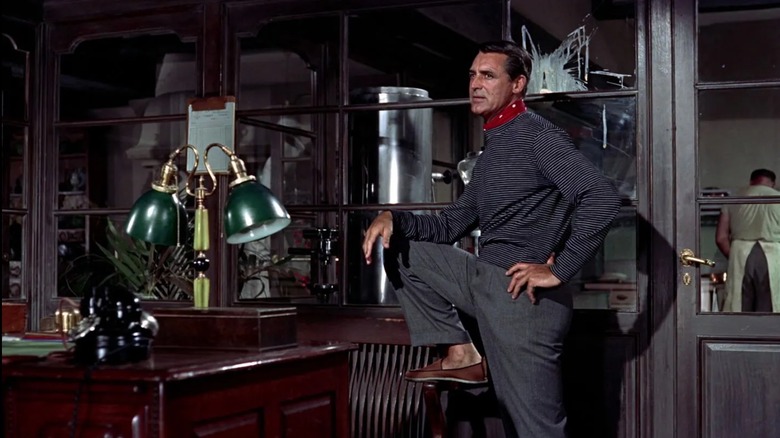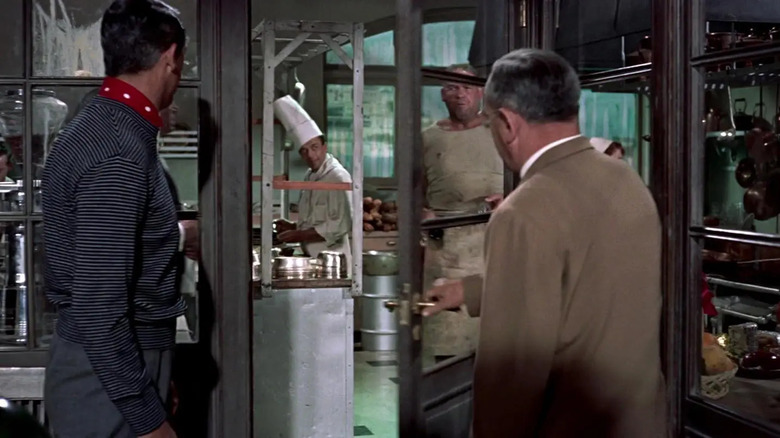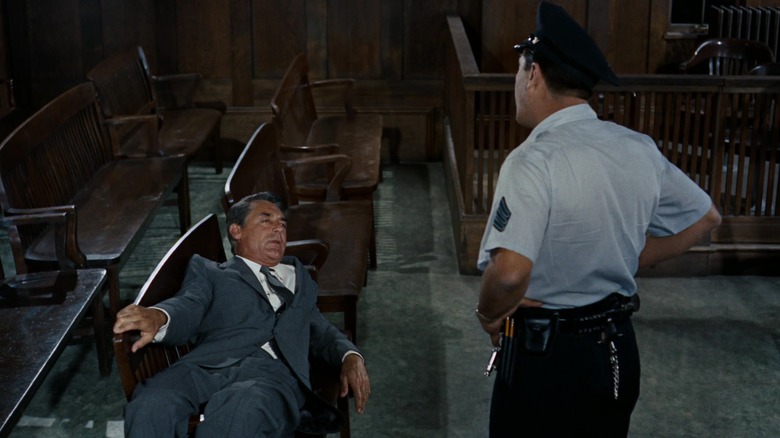Alfred Hitchcock Knew When To Give Cary Grant Room To Work
There's just something about Old Hollywood's leading men. Equal parts suave and brooding, it's easy to feel as though they could charm their way into anything (a feat no doubt influenced by film noir's popularity in '40s and '50s — and the genre's moody coolness). But while it may be tempting to brush off the allure as Hollywood glamour, Cary Grant nevertheless charmed his way into one of the most difficult places to reach: Alfred Hitchcock's heart.
It's no secret that Hitchcock was incredibly dismissive of his actors. Despite later dry jokes that he must have been misquoted, the director famously shared an analogy that compared actors to cattle. Putting comments aside, actions speak louder than words — and Hitchcock's behavior didn't always paint a pretty picture. Still, the director had quite the soft spot for Cary Grant, and even told producer George Barrie that "Knowing Cary is the greatest association I've had with any film actor. Cary is the only actor I ever loved in my whole life." With comments like that, it's no surprise that Hitchcock was remarkably lenient with Grant and even welcomed him as a collaborator on-set.
No corralling here, folks
Surprisingly, despite their close rapport and the sheer size of each man's filmography, Hitchcock and Grant would only work on four films together: "Suspicion," "Notorious," "To Catch a Thief," and "North by Northwest." However, by the time that the duo worked on "To Catch a Thief," Hitchcock was open to taking suggestions from Grant — and not just musings about character motivation, but ideas about camera angle and other technical details. In a later interview, Greg Garris recalled standing behind Hitchcock and watching as Grant was allowed to explore different creative decisions:
"[Once a shot finished shooting,] Grant comes over to Hitchcock and he says, 'Alfred ... I've got to tell you ... I felt that if I just moved my right shoulder just a bit like that and maybe the camera was just a touch over my shoulder, maybe we could get a better reaction from [Camera] B if I did all of that. What do you think about that?' Hitchcock went, 'Okay, let's try that.' ... [so] they [film] again and again and again ... and every time Grant comes over [with more suggestions]"
That type of creative collaboration is somewhat surprising for Hitchcock, who was not opposed to last-minute changes but built a reputation for shaking off his actors (to say the very least). Allegedly, Hitchcock wasn't even interested in making sure that his casts understood their characters' motivation, instead telling them to find inspiration in their paycheck — which makes Grant's collaboration all the more unusual.
It wasn't a free-for-all
While it might be shocking to hear that Grant had so much input on set, the collaboration largely worked because of the mutual respect between director and actor. According to Garris, Hitchcock knew that Grant could be trusted because he had worked on so many films — around 60 by this point — while Grant was still relatively humble because he knew that Hitchcock would ultimately have the final say in which shot would be used.
This environment encouraged Grant to come up with ideas that would benefit Hitchcock's vision, making it all the more likely that the director appreciated the collaboration. In return, Hitchcock would help Grant, too — not only by casting him in films, but also by giving him coping strategies to diffuse on-set tensions.
Curiously though, Grant never put his knack for fiddling with shot setups to much use. Although he starred in a handful of films following his collaborations with Hitchcock, the actor never branched out into directing — a path that feels like a given considering his ability to envision different scene possibilities. Perhaps Grant wanted to play to his talents (and help Hitchcock's shine).


